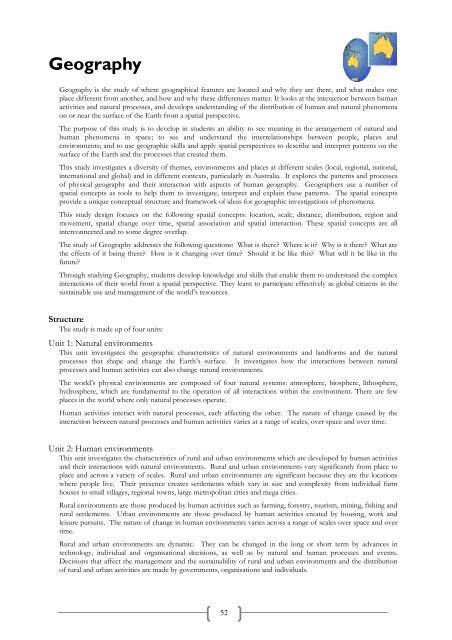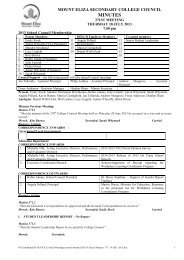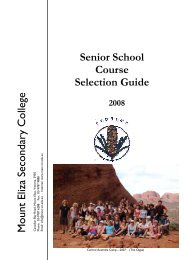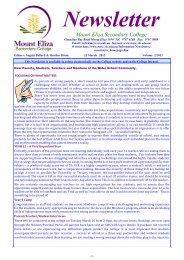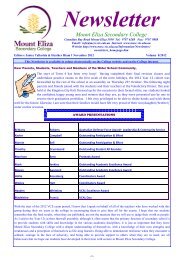9-12 Course Selection Guide - Mount Eliza Secondary College
9-12 Course Selection Guide - Mount Eliza Secondary College
9-12 Course Selection Guide - Mount Eliza Secondary College
You also want an ePaper? Increase the reach of your titles
YUMPU automatically turns print PDFs into web optimized ePapers that Google loves.
GeographyGeography is the study of where geographical features are located and why they are there, and what makes oneplace different from another, and how and why these differences matter. It looks at the interaction between humanactivities and natural processes, and develops understanding of the distribution of human and natural phenomenaon or near the surface of the Earth from a spatial perspective.The purpose of this study is to develop in students an ability to see meaning in the arrangement of natural andhuman phenomena in space; to see and understand the interrelationships between people, places andenvironments; and to use geographic skills and apply spatial perspectives to describe and interpret patterns on thesurface of the Earth and the processes that created them.This study investigates a diversity of themes, environments and places at different scales (local, regional, national,international and global) and in different contexts, particularly in Australia. It explores the patterns and processesof physical geography and their interaction with aspects of human geography. Geographers use a number ofspatial concepts as tools to help them to investigate, interpret and explain these patterns. The spatial conceptsprovide a unique conceptual structure and framework of ideas for geographic investigations of phenomena.This study design focuses on the following spatial concepts: location, scale, distance, distribution, region andmovement, spatial change over time, spatial association and spatial interaction. These spatial concepts are allinterconnected and to some degree overlap.The study of Geography addresses the following questions: What is there? Where is it? Why is it there? What arethe effects of it being there? How is it changing over time? Should it be like this? What will it be like in thefuture?Through studying Geography, students develop knowledge and skills that enable them to understand the complexinteractions of their world from a spatial perspective. They learn to participate effectively as global citizens in thesustainable use and management of the world’s resources.StructureThe study is made up of four units:Unit 1: Natural environmentsThis unit investigates the geographic characteristics of natural environments and landforms and the naturalprocesses that shape and change the Earth’s surface. It investigates how the interactions between naturalprocesses and human activities can also change natural environments.The world’s physical environments are composed of four natural systems: atmosphere, biosphere, lithosphere,hydrosphere, which are fundamental to the operation of all interactions within the environment. There are fewplaces in the world where only natural processes operate.Human activities interact with natural processes, each affecting the other. The nature of change caused by theinteraction between natural processes and human activities varies at a range of scales, over space and over time.Unit 2: Human environmentsThis unit investigates the characteristics of rural and urban environments which are developed by human activitiesand their interactions with natural environments. Rural and urban environments vary significantly from place toplace and across a variety of scales. Rural and urban environments are significant because they are the locationswhere people live. Their presence creates settlements which vary in size and complexity from individual farmhouses to small villages, regional towns, large metropolitan cities and mega cities.Rural environments are those produced by human activities such as farming, forestry, tourism, mining, fishing andrural settlements. Urban environments are those produced by human activities created by housing, work andleisure pursuits. The nature of change in human environments varies across a range of scales over space and overtime.Rural and urban environments are dynamic. They can be changed in the long or short term by advances intechnology, individual and organisational decisions, as well as by natural and human processes and events.Decisions that affect the management and the sustainability of rural and urban environments and the distributionof rural and urban activities are made by governments, organisations and individuals.52


